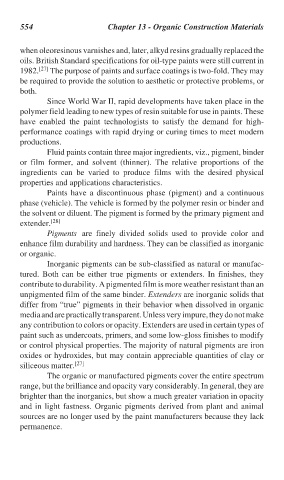Page 584 - Handbook of Thermal Analysis of Construction Materials
P. 584
554 Chapter 13 - Organic Construction Materials
when oleoresinous varnishes and, later, alkyd resins gradually replaced the
oils. British Standard specifications for oil-type paints were still current in
1982. [27] The purpose of paints and surface coatings is two-fold. They may
be required to provide the solution to aesthetic or protective problems, or
both.
Since World War II, rapid developments have taken place in the
polymer field leading to new types of resin suitable for use in paints. These
have enabled the paint technologists to satisfy the demand for high-
performance coatings with rapid drying or curing times to meet modern
productions.
Fluid paints contain three major ingredients, viz., pigment, binder
or film former, and solvent (thinner). The relative proportions of the
ingredients can be varied to produce films with the desired physical
properties and applications characteristics.
Paints have a discontinuous phase (pigment) and a continuous
phase (vehicle). The vehicle is formed by the polymer resin or binder and
the solvent or diluent. The pigment is formed by the primary pigment and
extender. [28]
Pigments are finely divided solids used to provide color and
enhance film durability and hardness. They can be classified as inorganic
or organic.
Inorganic pigments can be sub-classified as natural or manufac-
tured. Both can be either true pigments or extenders. In finishes, they
contribute to durability. A pigmented film is more weather resistant than an
unpigmented film of the same binder. Extenders are inorganic solids that
differ from “true” pigments in their behavior when dissolved in organic
media and are practically transparent. Unless very impure, they do not make
any contribution to colors or opacity. Extenders are used in certain types of
paint such as undercoats, primers, and some low-gloss finishes to modify
or control physical properties. The majority of natural pigments are iron
oxides or hydroxides, but may contain appreciable quantities of clay or
siliceous matter. [27]
The organic or manufactured pigments cover the entire spectrum
range, but the brilliance and opacity vary considerably. In general, they are
brighter than the inorganics, but show a much greater variation in opacity
and in light fastness. Organic pigments derived from plant and animal
sources are no longer used by the paint manufacturers because they lack
permanence.

